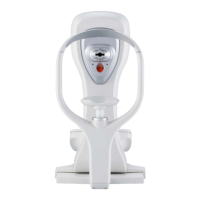9 Device Description
Instruction Manual Corvis® ST (G/72100/XXXX/EN 1019 Rev01) 15 / 80
9.2 Mode of Operation of the Corvis® ST
The Corvis® ST is a non-contact tonometer equipped with an optical
Pachymetry function.
The Corvis® ST measures intraocular pressure without contact with the
eye by applying an air puff to the eye. During the air puff the eye gets
illuminated by a 9 mm slit through the apex and a built-in high-speed
camera records the movement of the eye with more than 4000 images per
second.
The high-speed camera uses a sequence of 140 Scheimpflug images of
the cornea which are analyzed by a built-in computer.
Intra ocular pressure is determined by the detection of the applanation
moments of the cornea.
Based on the Imbert-Fick principle the intraocular pressure is calculated
by dividing the amount of air pressure into the area of applanated surface.
The device increases the air pressure puffed onto the cornea in proportion
to time. The shape of the cornea changes from the normal convex surface
to a concave surface.
This change is optically detected within 140 Scheimpflug images. The
device calculates the time required to applanate (plane shape) the cornea
with the air puff.
The slit light illuminates a sectional plane from the front surface of the
cornea to the back surface during the air puff. The transparent cells of the
cornea scatter the slit light such that the sectional plane appears as if it
were self-luminous.
This is captured at an angle of 45° through the pupil by a camera, whereby
the image plane of the camera is also tilted 45° to the optical axis of the
camera lens, in order to sharply focus the light-scattering cornea plane
onto the image plane of the camera (Scheimpflug image).
Due to this arrangement, sharp sectional images of the cornea can be
obtained.
The pachymetry principle uses also the sectional images of the cornea.
Corneal thickness and shape are obtained from images when the Cornea
is not influenced by the air puff.
Tonometry and Pachymetry are measured at the same measurement
process.

